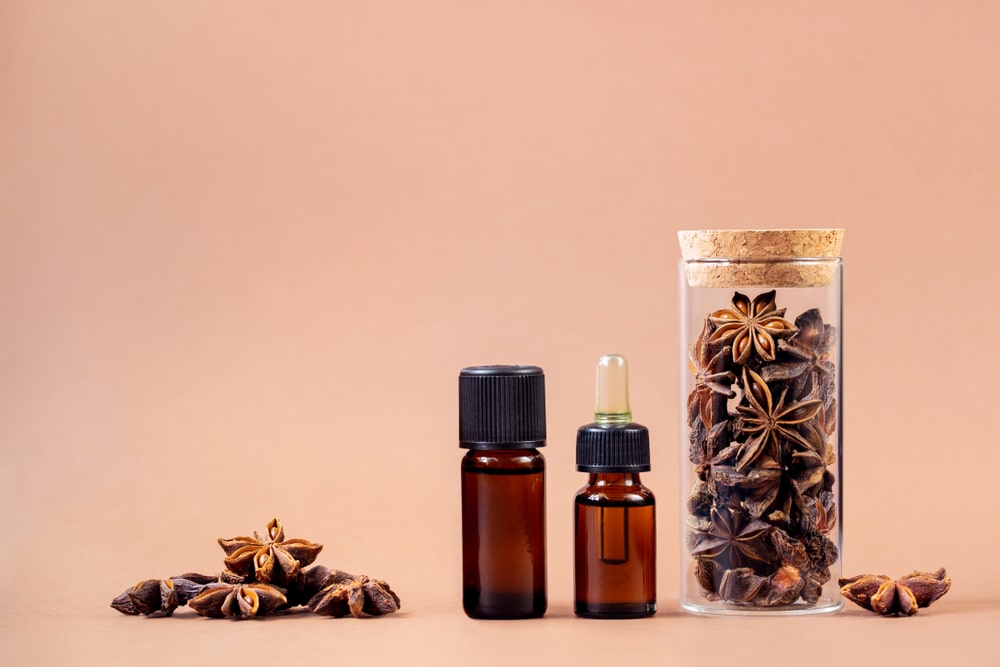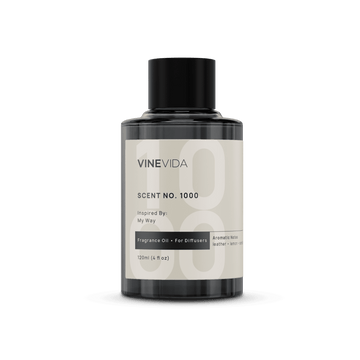Admit it. You bought the star anise essential oil for its delicious warming fragrance. You diffused it, got bored, and don't know what to do with it now! We know. We've been there. Hence this article.
If you want to read the science and research into the oil, look at our post on star anise essential oil. It's a busy oil with lots of news around it. Star anise is a relatively stable essential oil that should last about four years if you take care of the bottle and store it somewhere cool and dark.
So there is no rush to use it too fast, but let's see if we can get creative here. Apart from making the best mulled wine, what is star anise essential oil good for?
What Does Star Anise Blend Well With
Think woods like cedarwood, sandalwood, or cypress. Naturally, it goes well with other spices like ginger, cinnamon, and nutmeg. Rich balsamic resins like myrrh and galbanum. It is lovely with sweet, rich, scented flowers like rose, geranium, jasmine, ylang-ylang, and neroli. Herbs are more challenging to blend with. You might want to look for citruses like a lemon, that can sit between the fragrances. Then things like eucalyptus and peppermint work together a bit more easily.
1. Breath Freshening Mouthwash
Ordinarily, you would have to use alcohol to disperse your essential oils. However, there are lots of people who should not be around alcohol for a variety of reasons. Since milk is a fat-based substance, this works well because now the oils will be absorbed…a bit. Don't get carried away! The honey helps too. This recipe is delicious and designed to be swooshed around the mouth and spat out. Do not ingest it. It makes sense to re-rinse with water afterward to check that your teeth are lovely and clean before bed.
- 1 glass of Milk
- 1 teaspoon Honey
- 1 drop Cinnamon Essential Oil (Cinnamomum Verum)
- 1 drop Star Anise Essential Oil (Illicium verum)
- 1 drop Clove Essential Oil (Syzygium aromaticum)
Method of use: Swoosh around your mouth for thirty seconds, then spit. Rinse with water
Safety: Not ideal for use by children under the age of two.
Also Read: Ways to Use Vanilla
2. Indigestion
- 1 teaspoon Grapeseed Carrier Oil (Vitis vinifera)
- 1 drop Roman Chamomile Essential Oil (Anthemis nobilis)
- 1 drop Star Anise Essential Oil (Illicium verum)
- 1 drop Carrot Seed Essential Oil (Daucus carota)
Method of use: Rub over the chest and abdomen during painful moments.
Safety: Not suitable for use during pregnancy.
Also Read: How To Use Vetiver Oil
3. Head Lice
- 12-oz bottle of Hair Conditioner
- 30 drops Tea Tree Essential Oil (Melaleuca alternifolia)
- 15 drops Neroli Essential Oil (Citrus aurantium)
- 30 drops Star Anise Essential Oil (Illicium verum)
Method of use:
- Leave it on for thirty minutes.
- Use a lice comb to comb through the hair well, rinsing the comb out in boiling water (which kills any surviving lice).
- Rinse the hair in vinegar, which loosens the glue that attaches the eggs, then rinse with warm water.
- Wash all bedding, hats, and hair brushes to get rid of eggs.
- Repeat three days later.
Safety: The star anise makes this not suitable for use during pregnancy.
Also Read: How To Use Frankincense Oil.
4. Hair Growth Conditioner
- 12-oz bottle of Hair Conditioner
- 30 drops of Cedarwood Essential Oil (Cedrus deodara)
- 15 drops Star Anise Essential Oil (Illicium verum)
- 5 drops Rosemary Essential Oil (Salvia rosmarinus)
Method of use: Leave for ten minutes, then rinse with warm water.
Safety: not suitable for use during pregnancy. Not suitable for people living with epilepsy or any delusory disorder (Rosemary).
Also Read: How to Use Essential Oils to Meditate
5. Erotic Diffuser
- 2 drops Star Anise Essential Oil (Illicium verum)
- 1 drop Patchouli Essential Oil (Pogostemon cablin)
- 1 drop Ylang-Ylang Essential Oil (Cananga odorata)
Safety: Not designed for topical use.
Also Read: 20 Aromatic Ways to Destress
6. Winter Warmer Candles
Take a tray of tea lights and put them into the oven to melt on low heat.
Drop your essential oils in, being careful to keep the oil away from the wick. (The smell when oils burn is not great!)
Then, pop your oils into each candle.
- 1 drop Star Anise Essential Oil (Illicium verum)
- 1 drop Sweet Orange Essential Oil (Citrus sinensis)
- 1 drop Nutmeg Essential Oil (Myristica fragrans)
Safety: Not designed for topical use.
Also Read: How to Use Eucalyptus Oil for Cough?
7. Hormonal Balance Rollerball
For days when you feel a little controlled by your body, whether during your menstrual cycle or perimenopause symptoms. Just to feel a little more level.
- 8 ml Grapeseed Carrier Oil (Vitis vinifera)
- 1 ml Rosehip Carrier Oil (Rosa canina)
- 3 drops Geranium Essential Oil (Pelargonium asperum var roseum)
- 1 drop Star Anise Essential Oil (Illicium verum)
- 1 drop Ylang-Ylang Essential Oil (Cananga odorata)
Method of Use: Rub onto pulse points on your wrists and the back of your neck when things feel overwhelming. It's nice to put a little in the palms of your hands and inhale them for a few moments, too. Then, forget about what's going on around you and sink into the world of flowers.
Safety: Not suitable for use during pregnancy.
Also Read: How To Use Lavender Oil For Sleep?
8. Coughs And Colds
- 20 ml Aqueous Cream (Available over the counter at the pharmacy)
- 3 drops Ravensara Essential Oil (Ravensara aromatica)
- 1 drop Star Anise Essential Oil (Illicium verum)
- 2 drops Myrrh Essential Oil (Commiphora myrrha)
Method of Use: Rub over the cheekbones and forehead to relieve congestion. Rub into the pulse points of your wrists to allow the oils to circulate in your bloodstream quickly.
Safety: Not suitable for use during pregnancy.
Also Read: How To Use Lavender Oil For Anxiety?
9. Cold Sores Lip Balm
This makes a large quantity, about 20oz, but it is easy to adapt to drive less. The magic formula is 2 parts oil, 1 part wax, and 1 part butter. Strictly speaking, you don't need a preservative because there is no water in the mix, but if you feel more comfortable adding it, use it at 1% of your mix. You can buy the tubes for lip balms, but it's just as easy to put this into small pots.
- 5 Oz Beeswax (Cera alba) or an emulsifying wax like Lanette wax
- 5 Oz Shea Butter (Vitellaria paradoxa) Cocoa butter is also lovely and gives a kind of chocolatey note.
- 10 Oz Almond Oil (Prunus amygdala) (Jojoba Oil works if you are allergic to nuts)
- 10 drops German Chamomile Essential Oil (Matricaria recutita)
- 10 drops Melissa Essential Oil (Melissa officinalis)
- 5 drops Star Anise Essential Oil (Illicium verum)
- 1 tsp Eco-preservative
Method of preparation:
- Melt your wax in a double boiler.
- Put water on the bottom and the wax on the top.
- When it is all melted, remove the heat, and add almond oil.
- Stir well to combine.
- Add your essential oils and preservative.
- Pour into containers and leave to cool.
- Do not cap them until they are cooled, so you do not trap any moisture that could cause mold.
Also Read: How to Use Essential Oils In a Diffuser
10. Pampering Your Plants
If you have indoor plants, you'll undoubtedly notice how dusty they get. I like to use rosewater to polish it off. It scents the room, and the plants seem happier in the glow. That's my opinion, and I'm sticking to it!
So, to adapt that for my rose garden, I'm using rose water, but feel free to omit it and take the regular water content up to 24 oz instead. Plant leaves like alcohol, but it is harmful if it gets down into the roots, so be mindful as you spritz, please.
Antifungal spray
- 16 Oz Distilled Water
- 8 Oz Rose Water (Rosa damascena)
- 3 Oz Alcohol
- 40 drops Star Anise Essential Oil (Illicium verum)
- 10 drops Clove Essential Oil (Syzygium aromatica)
- 10 drops Rose Geranium Essential Oil (Pelargonium asperum var roseum)
Method of use: Spray under the leaves, away from the roots, in the evening.
Safety: Wash hands thoroughly after use.
Also Read: How To Use Frankincense Essential Oil for Skin Care
Final thoughts
Of course, star anise essential oil is the fragrance of mulled wine, but it's so much more. Get experimental this year and see how many ways you can use your bottle.















